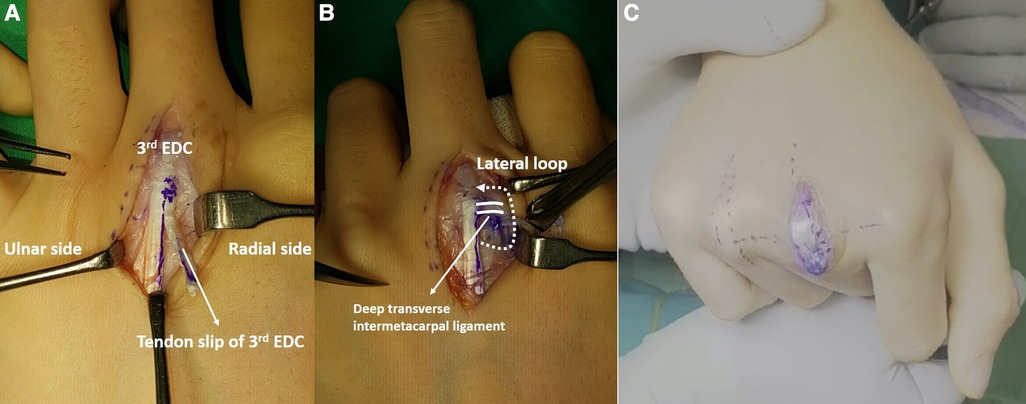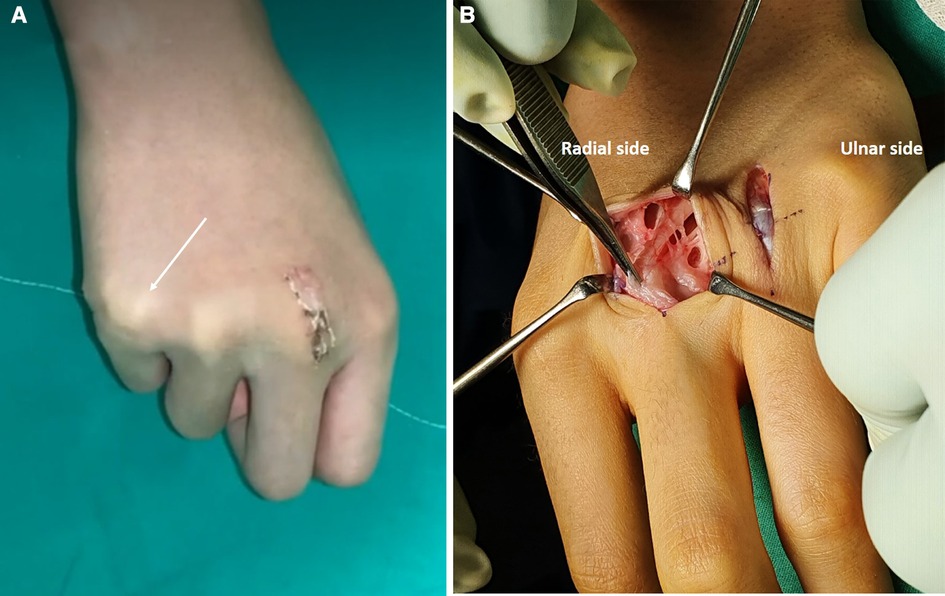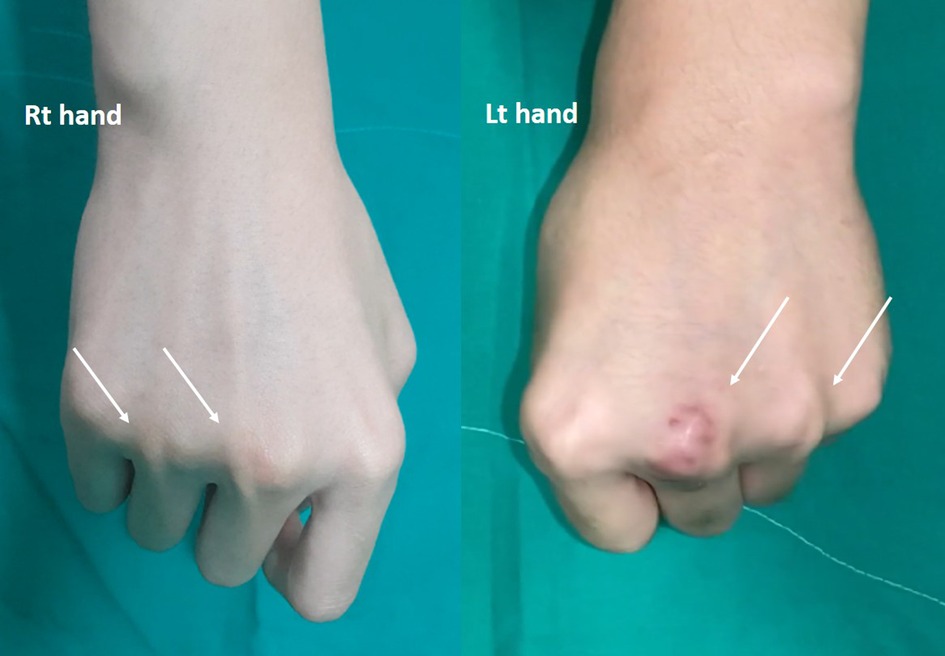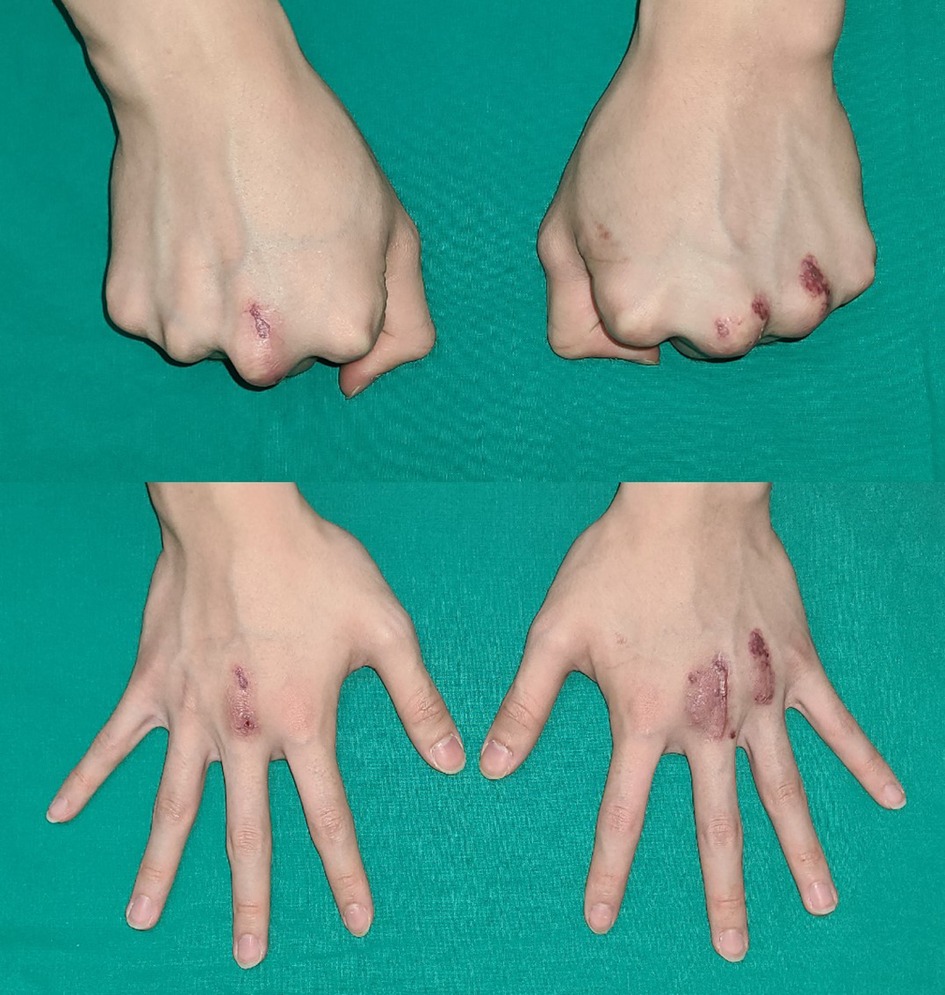- Department of Orthopedic Surgery, Chonnam National University Medical School and Hospital, Gwangju, Republic of Korea
Bilateral congenital dislocation of the extensor tendon in the metacarpophalangeal joint is an exceedingly rare disease and often involves multiple fingers. Surgical treatment of multiple congenital extensor tendon dislocations in both hands has been reported; however, no report has clearly stated whether all fingers should be surgically treated in patients with multiple finger involvement. We report a case in which we successfully treated bilateral congenital extensor tendon dislocation on multiple digits with only one single-loop reconstruction of the sagittal band instead of operating on all involved fingers.
1. Introduction
Dislocation of the extensor tendons from their central position on the metacarpal heads can be traumatic, congenital, spontaneous, or degenerative (1–3). Congenital dislocation of the extensor tendons occurs mostly in children and affects multiple digits bilaterally (2, 3). The sagittal band that tightens the extensor hood and holds the tendons over the metacarpophalangeal (MCP) joints during flexion is the principal centralizing structure (1, 4). Other anatomic structures (i.e., intertendinous fascia and the juncturae tendinae) can behave as secondary stabilizers of the extensor tendons (3, 5). Failure of the sagittal bands to centralize the tendon and the absence of secondary stabilizers can cause dislocation of the extensor tendons.
Although various surgical techniques have been reported, the pathoanatomy of the dislocation and its appropriate treatment for congenital extensor tendon dislocation remains unknown due to the rarity of the condition. We report a case wherein we successfully treated bilateral congenital extensor tendon dislocation on multiple digits using a single-loop reconstruction of the sagittal band on a single digit.
2. Case description
This study is performed with an informed consent form signed by the patient and parents. A 14-year-old boy presented to our hospital with a complaint of pseudo-triggering accompanied by pain in the third and fourth fingers in both MCP joints bilaterally. The patient underwent a sagittal band repair on the left third finger after being diagnosed with traumatic sagittal band rupture at a local clinic 4 months prior. However, at the time of diagnosis, the patient had no history of trauma, and the dislocation presented in the third and fourth MCP joints on both hands. After the first surgical intervention, his parents noted that swelling, pain, and pseudo-triggering persisted. The patient also had noted the pseudo-triggering since childhood. A zigzag incisional wound on the left third MCP joint was visible on preoperative physical examination. With grasping, bilateral subluxation of extensor tendons of the third and fourth fingers on the metacarpal heads toward the ulnar side were observed (Figure 1). The Beighton score for generalized joint laxity was 3 points. We planned to perform a sagittal band reconstruction on the third and fourth finger with a 2-week interval starting with the unoperated right hand.
2.1. Surgical procedure and outcome
A longitudinal, radial-side curved incision was made over the MCP joint on the right third finger. During surgery, we observed a defect on the radial sagittal band of the right third finger with no further obvious defects. The third sagittal band reconstruction was performed using the Elson technique (Figures 2A,B). After reconstruction of the right third sagittal band, we observed that the dislocation of the extensor tendon of the fourth finger was corrected spontaneously (Figure 2C). We decided to change the original surgical plan and avoid reconstruction of the sagittal band of the fourth finger and finished the right-hand operation. After 1 week from the operation, we observed a new radial-side dislocation of the extensor tendon of the right fifth finger (Figure 3A). We hypothesized that it was due to radial-side pulling force imposed from a reconstructed sagittal band. We followed-up the patient without any intervention. Radial-side extensor tendon dislocation of the right fifth finger was spontaneously resolved 5 days after the occurrence. After 2 weeks from the first operation on the right hand, we made a zigzag incision along the previous incision site on the left third finger and sagittal band reconstruction was performed using the same technique. Similarly, we decided not to reconstruct the left fourth sagittal band and finished the operation after confirming the spontaneous correction of the left fourth extensor tendon dislocation.

Figure 2. (A,B) Sagittal band reconstruction using tendon slip of the right third EDC using the Elson technique (6). The dotted line and arrow indicate the direction in which radial-side tendon slip of the third EDC passes under the deep transverse intermetacarpal ligament, forms a lateral loop, and returns to the third EDC tendon. The solid line indicates the deep transverse intermetacarpal ligament. (C) Disappeared sagittal band dislocation of right fourth finger after reconstruction of third sagittal band. EDC, extensor digitorum communis.

Figure 3. (A) A temporary radial-side dislocation of the right fifth extensor tendon after sagittal band reconstruction of the third finger. (B) Soft tissue adhesion on reconstruction site on the left third finger and no reconstruction of the fourth sagittal band.
Three months post-surgery, the ulnar side dislocation of the left third and fourth extensor tendons newly developed. We initially hypothesized that it was a recurred tendon dislocation and planned to have a revisional surgery on the third finger and a reconstruction on the fourth finger simultaneously. However, during the surgery, we observed adhesion of the surrounding soft tissue on the reconstruction site of the left third finger and did not find any evidence of failure on the reconstruction site. Accordingly, we carefully performed adhesiolysis and meticulously checked for dislocation of the left fourth extensor tendon. After the procedure on the third finger, the extensor tendon dislocation on the fourth finger was resolved spontaneously; hence, we could finish the surgery only with adhesiolysis without reconstruction of the fourth sagittal band (Figure 3B). The range of motion of the proximal interphalangeal joint was maintained with MCP joint immobilization in a 30° flexion under a short arm splint for 2 weeks after surgery. After 2 weeks, the splint was removed and passive joint motion of the MCP joint was performed. No recurrence of the extensor tendon dislocation or pain occurred in the MCP joint until 18 months post-surgery (Figure 4).
3. Discussion
Congenital sagittal band deficiency is a rare disease that occurs mostly in children. Although the related gene is not yet known, it is thought to be an autosomal dominant trait that may occur bilaterally and in multiple digits (3, 7–9). The main symptoms in patients with congenital extensor tendon dislocation include swelling around the MCP joint as well as pain and discomfort that worsen during flexion of the joint thus requiring surgical stabilization.
To date, various techniques have been reported for the surgical treatment of congenital extensor tendon reconstruction including soft tissue reconstruction using an extensor digitorum communis tendon slip (10) or a thin rectangular capsular flap (7) and indirectly increasing the tension of the sagittal band by repositioning the metacarpal bone without soft tissue surgery (11). Congenital extensor tendon dislocation is said to be caused by defects in juncturae tendinae, which is responsible for redistribution of the forces across the web and stabilization of the MCP joint (3, 12). A cadaveric study showed that juncturae tendinum and the sagittal band make an integrated contribution to MCP joint stabilization, especially during the coordinated digit flexion (13, 14). However, based on the intraoperative observation in the current study, it is unclear whether these two structures are the cause or if the intertendinous fascia and other structures responsible for recentering the extensor tendon may be the cause of dislocation (5).
This study reported the successful treatment of multiple congenital extensor tendon dislocation in a patient who underwent sagittal band reconstruction in only one digit in each hand. The dislocation of the fourth finger self-corrected after the reconstruction of the third finger on both sides. This finding suggested that there might be a connection between the extensor tendons and each tendon might be affected by pulling force. Therefore, the treatment of congenital multiple-digit extensor dislocation can be possible with only the most radial or ulnar side reconstruction without operating on all involved fingers. In addition, this hypothesis could explain the temporary subluxation of the fifth finger to the radial side. Further studies are needed to evaluate the connection between extensor tendons in patients with congenital extensor dislocation.
In our review of the literature, we found no reports on the direct repair of congenital extensor dislocation. Meanwhile, various sagittal band reconstruction techniques have been described in non-congenital extensor tendon dislocation cases including transposition of the extensor tendon with a displaced hood (15), creation of a retrograde slip with a part of the extensor tendon and rotating it beneath the deep intermetacarpal ligament (6) or around the volar interosseous muscle and anchoring it to the radial-side capsule (16), juncturae tendinum reconstruction (17), modification of the Elson technique using the extensor indicis proprius for the index finger sagittal band reconstruction in a patient with chronic sagittal band dislocation (18), and creation of a new pulley using a distended radial sagittal band and anchoring it to the surrounding extensor tendon (19). In our case, we observed that the dislocation recurred after a direct repair. As such, we believe that reconstruction surgery might be the better option compared to conservative or repair treatment due to a high possibility of the absence or deficiency of intertendinous structures, making it less likely to fail.
We found the self-resolution of the radial-side dislocation of the right fifth extensor tendon 5 days after sagittal band reconstruction of the third finger. We believe that self-resolution of the radial dislocation of the fifth extensor tendon may be due to stress relaxation. Stress relaxation is a mechanical property of tendons that refers to their ability to gradually decrease their tension or stress under constant deformation over time (20). In the case of radial-side dislocation of the fifth extensor tendon following sagittal band reconstruction of the third finger, the tension on fifth extensor tendon due to pulling force exerted on the juncturae tendinum may have initially increased due to the altered mechanics and forces in the hand. However, over time, the tension applied to the fifth extensor tendon may have undergone stress relaxation, leading to a decrease in tension and subsequent spontaneous improvement of the radial-side dislocation.
We found adhesions only on the third finger reconstruction site of the left hand and determined that this was due to pseudo-triggering recurrence. In addition, the left- and right-hand rehabilitation methods were slightly different from the method we initially presented to the patient. This was due to a delayed initiation of the range of motion (ROM) rehabilitation and the previous operation on the left finger. Many studies used buddy taping or application of a flexion-block splint for about 3–4 weeks post-surgery and performed active ROM to achieve full ROM for approximately 8 weeks. This recovery method has reportedly yielded positive results without dislocation recurrence or snapping (18, 19, 21). Therefore, active ROM after the removal of the splint is important for the prevention of adhesions.
4. Conclusions
In conclusion, surgical reconstruction may be required in symptomatic patients with multiple congenital extensor tendon dislocations. When multiple digits are involved, only reconstruction of the most radial or ulnar digit is necessary instead of operating on all involved fingers. In addition, proper active rehabilitation is essential to prevent postoperative adhesion.
Data availability statement
The original contributions presented in the study are included in the article, further inquiries can be directed to the corresponding author.
Ethics statement
The studies involving human participants were reviewed and approved by Chonnam National University Hospital Institutional Review Board. Written informed consent to participate in this study was provided by the participants’ legal guardian/next of kin. Written informed consent was obtained from the individual(s), and minor(s)' legal guardian/next of kin, for the publication of any potentially identifiable images or data included in this article.
Author contributions
SK and S-TJ contributed to manuscript conception, methodology, review, and supervision. JHC drafted and revised the manuscript. J-HL examined the patient and contributed to manuscript conception, data curation, original draft preparation, and editing. All authors contributed to the article and approved the submitted version.
Conflict of interest
The authors declare that the research was conducted in the absence of any commercial or financial relationships that could be construed as a potential conflict of interest.
Publisher's note
All claims expressed in this article are solely those of the authors and do not necessarily represent those of their affiliated organizations, or those of the publisher, the editors and the reviewers. Any product that may be evaluated in this article, or claim that may be made by its manufacturer, is not guaranteed or endorsed by the publisher.
References
1. Ishizuki M. Traumatic and spontaneous dislocation of extensor tendon of the long finger. J Hand Surg Am. (1990) 15:967–72. doi: 10.1016/0363-5023(90)90025-m
2. Inoue G, Tamura Y. Dislocation of the extensor tendons over the metacarpophalangeal joints. J Hand Surg Am. (1996) 21:464–9. doi: 10.1016/S0363-5023(96)80364-9
3. Kang N, Smith P. Congenital absence of the juncturae tendini contributing to dislocation of the extensor tendons. J Hand Surg Am. (2001) 26:501–5. doi: 10.1053/jhsu.2001.24141
4. Kettelkamp DB, Flatt AE, Moulds R. Traumatic dislocation of the long-finger extensor tendon. A clinical, anatomical, and biomechanical study. J Bone Joint Surg Am. (1971) 53:229–40. doi: 10.2106/00004623-197153020-00003
5. Araki S, Ohtani T, Tanaka T. Acute dislocation of the extensor digitorum communis tendon at the metacarpophalangeal joint. A report of five cases. J Bone Joint Surg Am. (1987) 69:616–9. doi: 10.2106/00004623-198769040-00021
6. Elson R. Dislocation of the extensor tendons of the hand: report of a case. J Bone Joint Surg Br Vol. (1967) 49(2):324–6. doi: 10.1302/0301-620X.49B2.324
7. Ozcanli H, Ozenci AM, Ozdemir H. Congenital dislocation of the extensor tendon of the hand. J Plast Surg Hand Surg. (2012) 46:447–9. doi: 10.3109/2000656X.2012.636971
8. Posner MA, McMahon MS. Congenital radial subluxation of the extensor tendons over the metacarpophalangeal joints: a case report. J Hand Surg Am. (1994) 19:659–62. doi: 10.1016/0363-5023(94)90278-X
9. Meriç G, Altınışık J, Atik A. Extensor tendon dislocation of the hand: six cases in a family. J Hand Surg Eur Vol. (2015) 40:315–6. doi: 10.1177/1753193413489083
10. Çırpar M, Dağlar B, Oktaş B. Congenital extensor tendon dislocation causing pseudotriggering of the little finger. Acta Orthop Traumatol Turc. (2017) 51:429–31. doi: 10.1016/j.aott.2017.03.016
11. Ozcelik IB, Sari A. A new technique in surgical treatment of congenital and spontaneous extensor tendon snapping: dorsalization-ulnarization of the metacarpal head. Hand Surg Rehabil. (2021) 40:782–6. doi: 10.1016/j.hansur.2021.07.008
12. Moore JR, Weiland AJ, Valdata L. Independent index extension after extensor indicis proprius transfer. J Hand Surg Am. (1987) 12:232–6. doi: 10.1016/s0363-5023(87)80277-0
13. Chinchalkar SJ, Barker CA, Owsley B. Relationship between juncturae tendinum and sagittal bands. J Hand Microsurg. (2015) 7:96–101. doi: 10.1007/s12593-015-0172-8
14. Farrar NG, Kundra A. Role of the juncturae tendinum in preventing radial subluxation of the extensor communis tendons after ulnar sagittal band rupture: a cadaveric study. Int Sch Res Notices. (2012) 30:4. doi: 10.5402/2012/597681
16. Michon J, Vichard P. Lateral luxations of the extensor tendons with regard to the metacarpophalangeal articulation. Rev Med Nancy. (1961) 86:595–601.13770304
17. ElMaraghy AW, Pennings A. Metacarpophalangeal joint extensor tendon subluxation: a reconstructive stabilization technique. J Hand Surg Am. (2013) 38(3):578–82. doi: 10.1016/j.jhsa.2012.12.021
18. Takahashi N, Iba K, Hanaka M, Ozasa Y, Kanaya K, Yamashita T. Sagittal band reconstruction in the index finger using a modified Elson technique. J Orthop Surg (Hong Kong). (2018) 26(1):2309499017749985. doi: 10.1177/2309499017749985
19. Woo S-H, Kim S-M, Ahn Y-S, Kim M-S. A novel technique of pulley creation for additional sagittal band reconstruction. Hand Surg Rehabil. (2021) 40(5):568–71. doi: 10.1016/j.hansur.2021.05.012
20. Robi K, Jakob N, Matevz K, Matjaz V. The physiology of sports injuries and repair processes. In: Hamlin M, Draper N, Kathiravel Y, editors. Curr Issues Sports Exerc Med. London: InTech (2013) p. 43–86.
Keywords: congenital extensor tendon dislocation, multiple digits, sagittal band reconstruction, juncturae tendinum, surgical treatment
Citation: Lim J-H, Jung S-T, Cheon JH and Kim S (2023) Treatment of bilateral congenital extensor tendon dislocation on multiple digits with only one sagittal band reconstruction: a case report. Front. Pediatr. 11:1078459. doi: 10.3389/fped.2023.1078459
Received: 24 October 2022; Accepted: 2 June 2023;
Published: 23 June 2023.
Edited by:
Jason Pui Yin Cheung, The University of Hong Kong, Hong Kong SAR, ChinaReviewed by:
Hoon Park, Gangnam Severance Hospital, Republic of KoreaIlaria Sanzarello, Università degli Studi di Messina, Italy
© 2023 Lim, Jung, Cheon and Kim. This is an open-access article distributed under the terms of the Creative Commons Attribution License (CC BY). The use, distribution or reproduction in other forums is permitted, provided the original author(s) and the copyright owner(s) are credited and that the original publication in this journal is cited, in accordance with accepted academic practice. No use, distribution or reproduction is permitted which does not comply with these terms.
*Correspondence: Sungmin Kim a2ltc3VtODNAZ21haWwuY29t
 Jun-Hyuk Lim
Jun-Hyuk Lim Sung-Taek Jung
Sung-Taek Jung Sungmin Kim
Sungmin Kim
